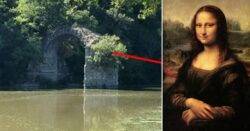There has been much debate about the bridge in the background of the painting (Picture: Getty/Le Rocca Cultural Association)
An Italian art historian believes he has identified the bridge in the background of the Mona Lisa.
Silvano Vinceti thinks the bridge featured in the famous painting’s pretty countryside backdrop is the Romito, in the small Italian town of Laterina, Tuscany.
He came to his conclusion after analysing historical documents and drone images while also comparing Leonardo da Vinci’s artwork and photos of the area.
He told reporters at the foreign press association in Rome that he had ‘no doubt’ he had spotted the right bridge.
The biggest giveaway was that the number of arches matched up, he said. The bridge in the Mona Lisa has four and Mr Vinceti believes the Romito did too.
Only one arch has actually remained intact from the 16th-century Etruscan-Roman bridge.
But Mr Vinceti measured the width in between the riverbanks and used the size of the surviving arch to work out that four arches of the same size would fit perfectly.
Mr Vinceti believes the size of the bridge’s arches match up with the four Da Vinci painted (Picture: Le Rocca Cultural Association)
The Mona Lisa was painted between 1503 and 1519 (Picture: Getty)
In the past, it has been speculated that the bridge is the Ponte Buriano – which has six arches – and the Ponte Bobbio which has more than six.
Mr Vinceti also argued that documents had shown the Romito was ‘a very busy, functioning bridge’ between 1501 and 1503.
He believes it was used as a shortcut between Florence and the town of Fiesole – where da Vinci often stayed with his uncle.
Laterina’s mayor Simona Neri said Mr Vinceti’s theory caused a lot of excitement in her town of just over 3,500 people.
She said: ‘We need to try to protect what’s left of the bridge, which will require funding.
‘There’ll be some rivalry; we’ll need to put a poster up.’
The Mona Lisa was painted between 1503 and 1519, the year of da Vinci’s death.
Get in touch with our news team by emailing us at webnews@metro.co.uk.
For more stories like this, check our news page.
The art historian measured the width in between the riverbanks and used the size of the bridge’s surviving arch to try and prove his theory.





